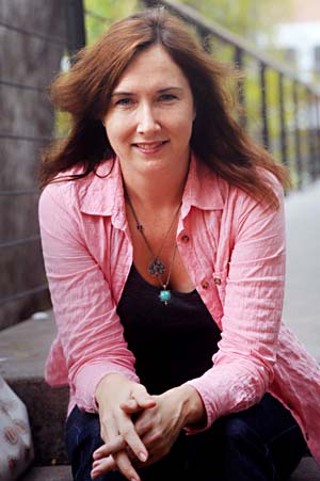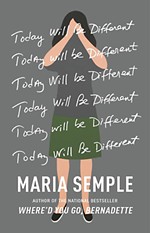From Nothing to Bounty
Playwright Lisa D'Amour muses on the distance between Austin and 'Detroit'
By Adrienne Martini, Fri., Oct. 19, 2012

Playwright/performance artist Lisa D'Amour is having a mobile year. Detroit, her play about backyards and entropy that was a Pulitzer Prize finalist in 2011, just opened off-Broadway, starring at least two actors you know well: David Schwimmer and Amy Ryan. (You also might know John Cullum, if you loved a show about Cicely, Alaska.) Before this interview, she was in Milton, Mass., where she was starting work on an immersive piece about the country's Miltons with her fellow interdisciplinary artist and longtime collaborator Katie Pearl. (See "Won't You Come In?," May 11, 2001.) Shortly after this conversation, D'Amour hopped on a plane to Austin to be on hand for rehearsals of her play The Cataract at the University of Texas Department of Theatre & Dance. And that's just the last few weeks. In May, she was in London for the National Theatre's staging of Detroit, and given the praises the play has received, her travel itinerary is bound to grow even more complicated.
D'Amour's career has always been peripatetic. She's from New Orleans and currently splits her time between there and New York City, where Nita and Zita, a PearlDamour collaboration, won an Obie award. D'Amour's artistic coming-of-age started in Austin, where she graduated with an MFA in playwriting from UT. She's bounced from Minneapolis, where The Cataract was born, to Houston; San Francisco; Providence, R.I.; and Chicago. And, obviously, Detroit.
Austin Chronicle: Why do you think Detroit was your breakthrough play? It seems to be the one that has gotten the most attention.
Lisa D'Amour: It's a breakthrough play in terms of breaking through to the mainstream. I'm going to press back against that phrase just a bit because there's this thing in people's consciousness that, like, suddenly if you get a good review in The New York Times you've made it. And that is completely counter to the way I feel about my career. I get a little antsy when people start going, "Well, obviously you tried to write a commercial play. Now you've finally broken through!" And I'm like, "Broken through to what? A new kind of hell?" [Laughs]
I think it's sort of obvious: It's a play about white people in backyards. That's my sad, sad answer. I mean, I think it's a good play. I'm really proud of the play. It shares a lot of similarities to my other work in terms of unlocking people that have a very familiar-looking surface but are deeply strange underneath. But I feel like somehow the frame of the backyard barbecue is recognizable enough that there were a lot of different entry points for a lot of different kinds of people. I also think it was almost a happy accident that I was writing it at the beginning of this economic crisis that won't go away. It's on people's minds all of the time. So they grab onto something that helps them make some kind of sense about what's going on. Maybe going to see Detroit makes you feel a little less lonely about your own financial anxieties because you're hanging out with these people who are way more freaked out than you are.
AC: How do you view Detroit in the context of your earlier work? Or your current work?
LD: The direct companion piece is being produced at UT-Austin, The Cataract. That play is two couples in 1883 in Minneapolis. It's a couple from the North, the husband of which is employed building an actual bridge in Minneapolis, which is called the Stone Arch Bridge. In order to make some money, they take in two boarders. They're kind of a wayward couple from the South, who've never really been in a lot of trouble but who have been travelers and have secrets. It's about the couples getting to know each other and getting to know themselves.
It has a much stranger surface than Detroit. The language is spare and stylized. In Detroit, people tell each other their dreams; in The Cataract, you actually see their dreams. There are middle-of-the-night scenes where you actually see a dream that the character is having. You feel the dream infect their daily lives, then by the second act, it's like a surreal dream life is actually happening in their real life.
I think many-slash-most writers start to realize that we're writing the same two or three plays over and over. You think you're not, but you always end it and you're like, "Oh, shit. Did it again." I feel like The Cataract was a rehearsal for Detroit or maybe a premonition of Detroit. But then I feel like all of my plays are ultimately big idea plays about consciousness and ontology. They're all like human beings stumbling through the world having no idea how they got here. In that way, they're all about me. [Laughs]
Then there's this other thing in all of my plays that has to do with the relationship between the civilized and the wild. That, of course, comes heavily into play in Detroit.
AC: What inspired The Cataract?
LD: Two things. I was obsessed with the Stone Arch Bridge. It was one of two pieces I've made that was trying to deal with this obsession. When I moved to Minneapolis, the Stone Arch Bridge was in a section of downtown that was completely dead. There were all of these empty old mills and factories that lined the river. Homeless people were sleeping there. The Stone Arch Bridge had just become a pedestrian path. They had taken out the railroad track. But nobody knew about it because there was nothing going on down there. All my friends in Minneapolis always wanted to jog around the lake, because it's the city of lakes. But I always wanted to go by the river because it connected me to New Orleans. So I was always dragging people to the Stone Arch Bridge and going, "Look at all these amazing buildings. I want to make a huge site-specific theatre piece in these one day."
In the meantime, I was like, why don't I just write a play about the history of the Stone Arch Bridge? It was kind of fascinating. And at the same time I had written 16 Spells To Charm the Beast and Anna Bella Eema, which were what I call baroque plays. The language was filled with flourishes and odd words. I wanted to give myself a restraint. I said, "OK, Lisa, you have to try to keep the language for The Cataract as spare as you possibly can. Almost mechanized. And you can only use two images: the river and the moon." Ultimately there were many more images than that. But I wanted to deal with restraint and the river. I just had this weird obsession with it.
AC: How do you balance between the more intensive performance pieces and site-specific performance pieces ...
LD: ... and playwriting?
AC: And the more standard playwriting where you hand it off ... ?
LD: It'll be interesting to see. It's getting a little more complicated because there have been three productions of Detroit in two years. Usually the playwright isn't quite as involved in all three, usually I would have handed it off by now, but because of the circumstances, I was really involved.
The way that I've balanced it in the past is with PearlDamour, we work on pieces for a long time before we show them. [Katie and I] don't live in the same city, so we've always operated, since 1997, by getting together for intense periods of time, working, and then going away. But now that we have more stuff going on – and, weirdly, PearlDamour has more stuff going on now than we ever have, too. How To Build a Forest is going to two places this year. We're starting to develop this Milton piece. Then this other piece, a play we started developing a couple of years into the future, looks like it's going to premiere next September in a big meadow at Longwood Gardens [near Philadelphia]. To be honest, right now managing both of them feels incredibly challenging. It takes a lot of self-discipline.
It's a really wild time of bounty for me right now. All of these opportunities for my plays are opening up because of the success of Detroit. Then Katie and I have been working really hard for 14 years, and we're getting more opportunities. Katie and I are trying to not feel the pressure of rushing and producing. We want to take our time and when the piece happens, it will happen. I think that's really the only way we can manage it.
AC: How did your time in Austin influence how you approach your work?
LD: I always tell people that I grew up in the theatre in Austin. I did theatre in New Orleans, but it was really that time in Austin when I was studying playwriting at UT and had some really amazing writing mentors in a formal situation. Then there was this, like, Texas Bohemia going on outside of UT, with Frontera@Hyde Park Theatre being the center of that, and then Salvage Vanguard Theater was happening at the same time.
People were just making things happen. There wasn't really a question of did you have the money or not. There was this weird feeling of everything being possible. Everything was about discovering the new, like how can we discover new ways, new forms. Every teacher that would pass through – and everybody would pass through, it was like the underground railroad of experimental artists: Laurie Carlos and David Hancock and Mac Wellman and Erik Ehn. It was sort of understood that they would come to workshop a play and they would also do a workshop. It was this really fertile time. That was my norm.
Look at a lot of the artists who came out of that time. We're all kind of fearless. I think that we were in this kind of theatre utopia with absolutely nothing. It had nothing to do with money. It had nothing to do with anything. We had ideas.
When you have that, you don't really lose that. I'm not trying to say that I'm not excited [about Detroit]. I mean, it's totally fucking insane that I have had two rave reviews in The New York Times for the same goddamn play. That is ridiculous. That is completely ridiculous. I understand that that is not anything to brush aside. It's a huge deal. But I also don't feel like that is what made me. What made me was making theatre in people's garages, and I will always have the garage.
AC: What do you wish I'd asked you about? What would you like to talk about?
LD: I'd like to talk about "How do we make more Austin from 1994-1999?" I'm really conscious of how hard it is to live in New York now, just how hard it is to live in cities, in some ways. I feel like I grew up at a time in the theatre when you could have a part-time job and make theatre and be OK. I actually don't know that that's true anymore. Even in a city like Austin.
One thing I've been thinking about is what are the circumstances that we need to nurture in order for that experimentation to be able to happen. I don't have kids. I'm 99 percent sure I'm not going to have kids, so I think a lot about what I can do to nurture the community to create those circumstances, since I'll probably have time over the next 20 years. It worries me a lot. I know there are other ways to make this kind of art, but that's the way I did it.
The Cataract runs Oct. 19-28 at the B. Iden Payne Theatre, 22 E. 23rd, on the UT campus. For more information, visit www.finearts.utexas.edu/tad.








